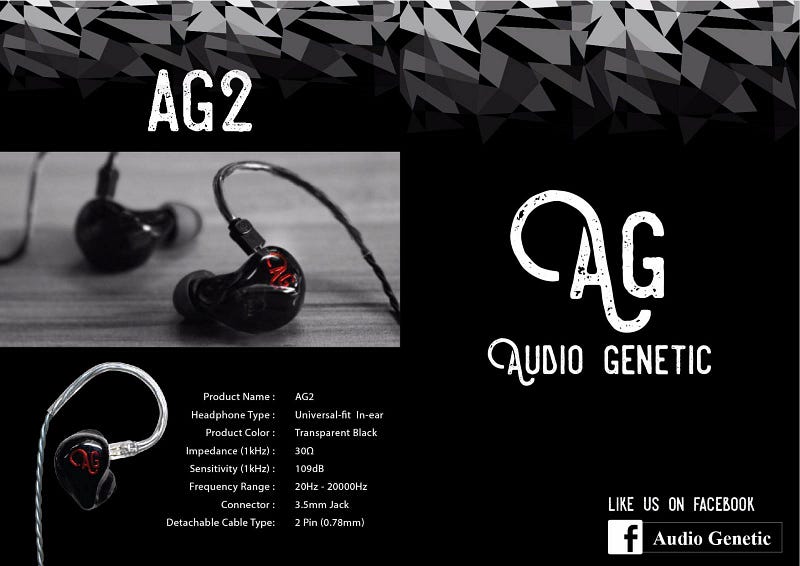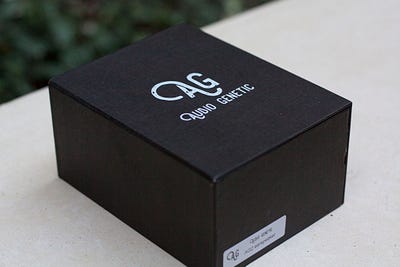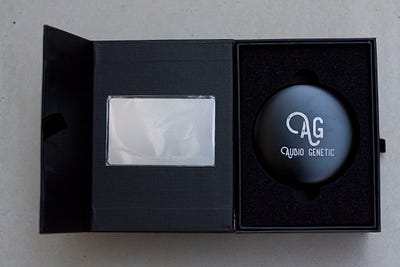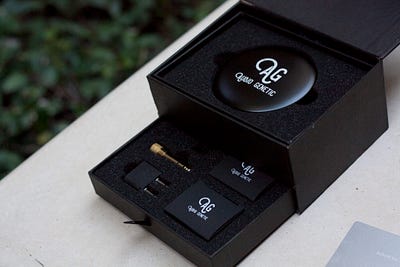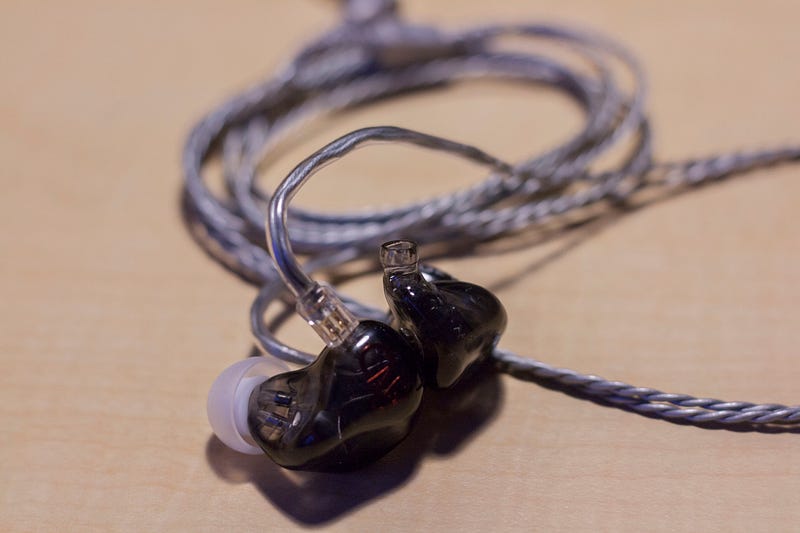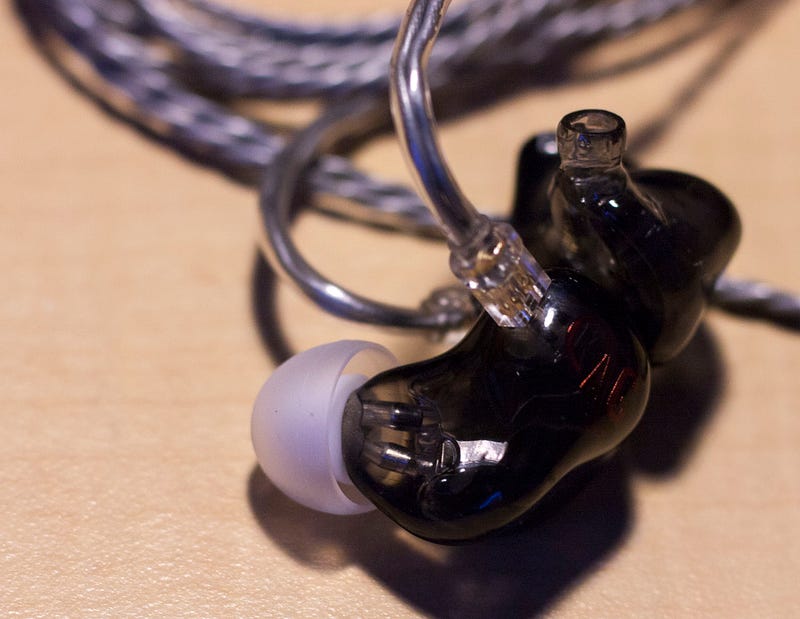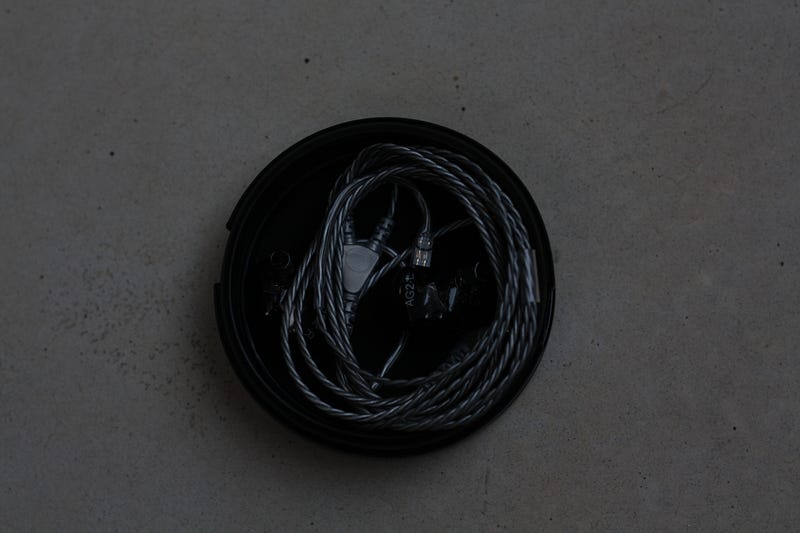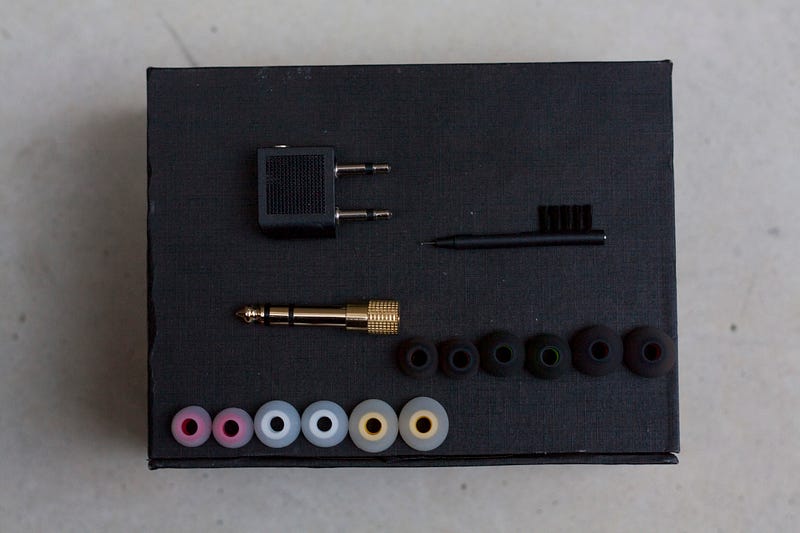Introduction –
Audio Genetic are a new manufacturer from Hong Kong with big ambitions. Like some of the most formidable manufactures from the West, their origins lie in custom cables, though they’ve since produced two IEMs. The AG2 represents their first effort, employing 2 balanced armature drivers in a low/mid + high configuration. In addition, the earphones implement litz copper wire to the low-frequency driver and litz silver to the high-frequency driver to maximise sonic performance. This isn’t unheard of, Plussound does the same with their IEMs, but at ~$450 USD, it’s an interesting proposition.

Now, that’s not to say that the AG2 is a cheap earphone; through some marketing madness, $450 doesn’t sound like a lot of money in a world where “midrange” IEMs stretch into the thousands. However, just a few years ago, $400 bought you a flagship TOTL in-ear. So it goes without saying that I have large expectations for a several hundred dollar earphone (and so should buyers), even if it’s only considered to be midrange in the present market. Thankfully, Audio Genetic lower no standards with their dual driver in-ear. You can purchase and read more about the AG2 on Audio Genetic’s Facebook page here.
Disclaimer –
I would like to thank Audio Genetic very much for their quick communication and for providing me with the AG2 for the purpose of review. All words are my own and there is no monetary incentive for a positive review. Despite receiving the earphones free of cost, I will attempt to be as objective as possible in my evaluation.
Accessories –

Though packaging doesn’t amount to much in the grand scheme of things, a nice unboxing can help legitimise a product. Despite being their first in-ear, the AG2 has a really interesting unboxing. The earphones come within a hard box that magnetically latches open.

Inside are the earphones and a practical aluminium carrying case. A drawer slides out from underneath housing the other accessories. The AG2 ships with a ¼” adapter, aeroplane adapter, cleaning tool.

In addition, Audio Genetic provide some really nice silicone ear tips, 3 pairs of generic tips and 3 pairs of authentic Accoustune tips. Both are nicely constructed with dense silicone and no moulding errors. I found the Accoustune tips to be a slightly more comfortable and slightly more detailed but those preferring a smoother sound may find better synergy with the standard tips.
Design –
Though not a unique design, the AG2 assumes one the best shell designs I’ve tested. They’re very well-formed with a sculpted inner face slotting perfectly into the outer ear. Their slim, protruding nozzles also provide a strong seal but a lack of filters does raise concerns regarding longevity. Though entirely plastic and mostly hollow, the earphones feel well-built due to their thick walls and a lack of any joining seems. They have a very smooth finish and no edges that wear on the ear during extended listening.
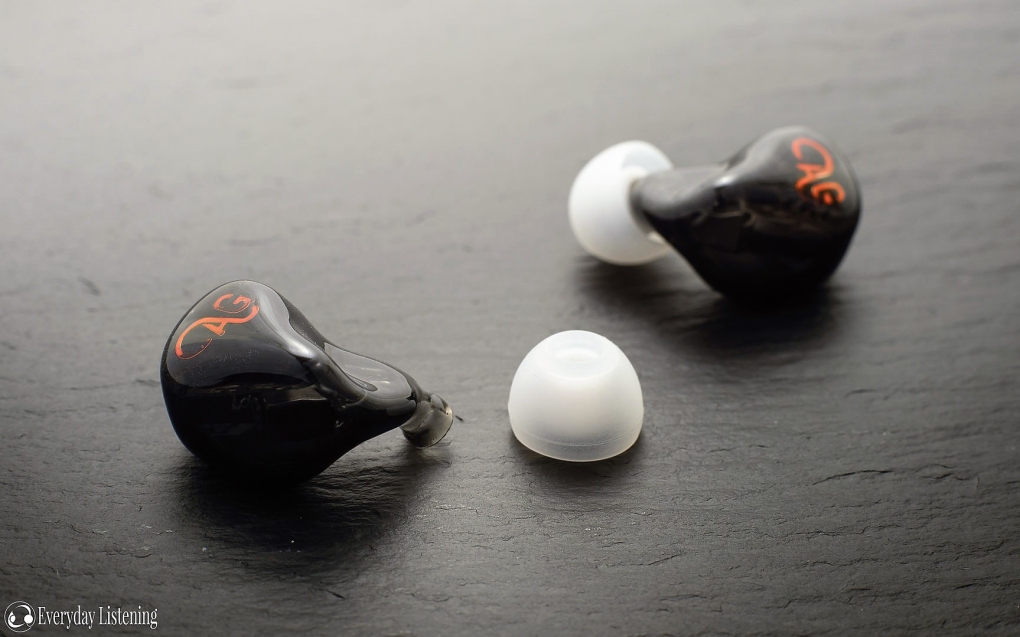
As such, I was very impressed with the comfort afforded by the AG2’s sculpted design; producing no hotspots even after hours of listening. Furthermore, as the AG is fully-sealed, the earphones produce high levels of noise isolation. Considering their long-term comfort and higher noise attenuation, the earphones are perfectly suited for commute on public transport and even air travel with a pair of foam tips.

Due to the earphone’s excellent housing design and over-ear fit, they’re also very stable in the ear. Their plastic construction makes them very lightweight so the earphones don’t budge during active use. They are a little larger in dimension, protruding a fair amount from the ear. As such, they aren’t especially well-suited for use while sleeping though wind-noise is a non-issue due to their smooth design.
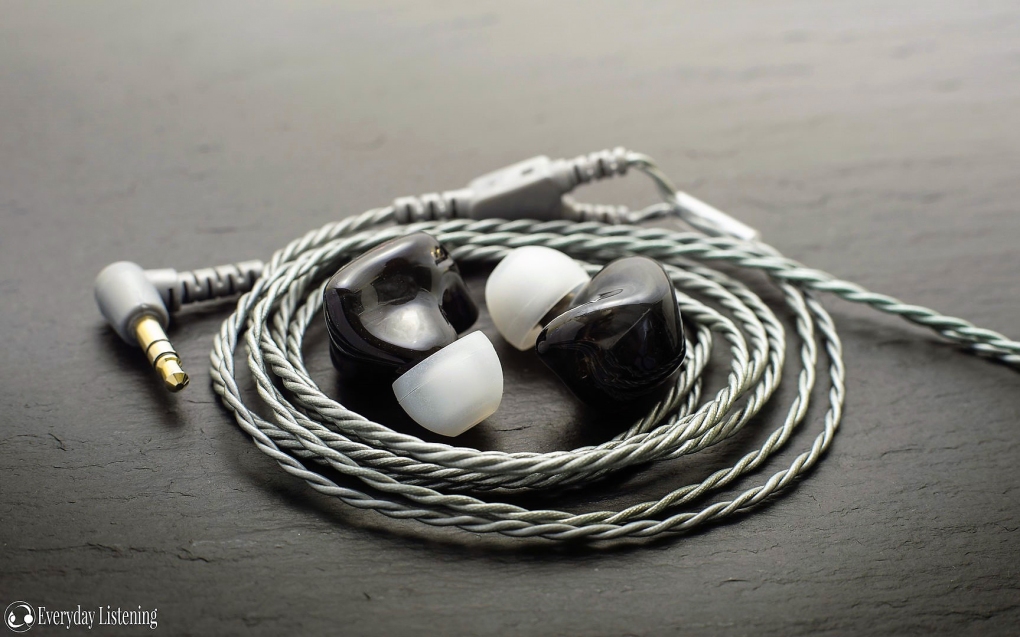
The AG2 utilises a 0.78mm non-recessed 2-pin cable. The plugs were tight and reliable during my testing, with no intermittency. The included cable is a fairly typical custom IEM style unit. It has a tightly twisted braid throughout and excellent strain relief on all terminations. The cable has a pocket-friendly right-angle 3.5mm plug though with no protrusion for cases. Up top, it’s using memory wire ear guides that held their position well. Still, I personally prefer pre-moulded guides.
Sound –
Tonality –
The AG2 is a very mature example of a mid-forward sound signature; well balancing intimate vocals with more engaging instruments. Its sound is slightly bright, stemming from a modest lower-treble peak in addition to a slightly brighter midrange tilt. As such, the AG2 reminds of earphones like the Rose BR5 MKII and Meeaudio Pinnacle P1, though it is more balanced and linear than both of these earphones. Of course, it does fall into some of the same pitfalls as other mid-forward IEMs by nature of its tuning. However, as price creeps higher, it’s all about refinement, the extent of its downfalls. In this regard, the AG2 excels, delivering a revealing sound without coming across as overly articulated.
Bass –
The AG2 delivers quite a natural bass presentation, and it does so despite being relatively neutral in quantity. Sub-bass extension is just average, lacking the physicality down low of higher-end models and dynamic driver IEMs. As such, it lends the impression of greater speed though the AG2 actually has more natural decay than most BA earphones. This produces more detailed, richly textured notes and the AG2 sounds quite dynamic without compromising separation. In addition, to achieve greater fullness and punch, mid-bass has a touch of additional emphasis.
This introduces a hint of warmth and body into their low-end, though no bloat is apparent. Upper-bass is also fairly linear, producing an accurately bodied midrange; where some brighter earphones tend to sound quite thin. What most impresses about the AG2’s bass response is its tightness, with terrific control throughout. This is most clearly highlighted by tracks with double bass drums where the AG2 remained composed and focussed. So, though not explicitly warm or engaging down-low, the AG2 lays the foundation for a transparent and well-controlled sound while maintaining pleasing dynamics.
Mids –
The midrange tends to draw attention on the AG2 through a combination of excellent clarity and a vocal forward presentation. Its brighter signature puts greater focus on female vocals though male vocals are also a little forward in the mix. In addition, the AG2’s lower-treble aggression prevents vocals from dominating instruments; so though the earphones aren’t neutral, they achieve a comfortable balance. I grew to love the AG2’s transparency in particular, which really aids background detailing and separation. They can sound a little raspy due to that aforementioned treble aggression, though both vocals and instruments remain well-bodied and devoid of excessive sibilance or stridence.
Upper-mids are the star of the show, both through their forward stage position and enhanced clarity. What separates the AG2 from most mid-forward earphones is their linear bass/lower-midrange transition that creates natural, even slightly full-bodied vocals. Resultantly, female vocals are flattered with natural body in addition to pleasing extension. The AG2 does appear to have a small dip between its upper-midrange and treble, aiding separation and granting vocals with a slightly smoother texture. Resolution is also a standout, contributing to the AG2’s resolving nature without resorting to excessive signature colouration. As such, though the AG2 is clear and revealing, it also doesn’t fatigue.
Highs –
The AG2’s top-end forms a continuation of its emphasized upper-midrange. As such, though certainly aggressive and a little peaky within its lower-treble, notes don’t sound overly thin. In addition, the AG2 retrieves a high amount of detail and its more aggressive nature brings those finer nuances to the fore. This emphasis sustains into the AG2’s middle-treble before gently falling off, serving to enhance air and shimmer. The AG2 doesn’t have the cleanest background as a result, but I found instruments to sound fairly accurate if pushed forward. This was conveyed most notably through realistic decay to cymbals and tastefully enhanced attack that contributes to their high-end clarity.
These comments extend to strings and high-hats that can sound slightly over-forward at times, but refrain from harshness or tizziness. Another aspect of the AG2 that thoroughly impresses is its top-end extension. Their excellent extension delivers very pleasing resolution which complements the earphone’s layering and background detail retrieval. So while the AG2 isn’t especially linear up top, it also isn’t excessively bright or peaky to the extent that instruments sound artificial or vocals raspy. As such, I find the AG2 to find a harmonious balance between revealing and precise.
Soundstage –
The AG2 delivers larger stage dimensions than most in-ears, stretching beyond the head, but they do lack the expansion of vented models and some earphones with a more laid-back presentation. Its stage is fairly well-rounded, with a slight focus on width over depth. Still, the AG2’s sound has defined layers with nice intermediate density and detail, producing accurate instrument placement and precise directional cues. Separation is very nice, especially within the AG2’s tight, controlled bass and layered, neutrally toned midrange. Highs can get a little messier due to that lower-treble peak that occasionally overshadows the finer details lying higher up.
Driveability –
The AG2 requires a little more voltage than most high-end IEMs but it isn’t overly source sensitive overall. Though Audio Genetic don’t provide any precise specifications, I measured a modest 32ohm impedance. Through a lower gain source like the iPod Nano 7G, the AG2 still sounded nicely balanced but it didn’t possess the end to end extension or resolution provided by something like the Fiio X7 MKII.

Fiio X7 MKII (AM3A): Relatively neutral signature, tight low-end combined with clear vocals and a slightly crunchy high-end. Slightly more forward upper midrange. Extended top-end, great resolution. Nice soundstage, lacking a little space compared to the DX200 and R6. Slightly too bright overall but a transparent pairing nonetheless. No audible hiss on low-gain.
Hiby R6: Nice synergy, slightly darker with more robust bass producing a more balanced sound. Great resolution with more defined midrange layering. Female vocals are slightly pushed back, lacking some intimacy but subjectively more balanced. Wider stage with enhanced separation. Highs are smoother yet extended, producing more natural instrument timbre. No audible hiss, higher output impedance didn’t overly affect the AG2.
iBasso DX200 (AMP5): Well-balanced, very controlled low-end combined with slightly fuller, smoother vocals. Sounds a little more natural but also very resolving. The DX200 provided the most detailed pairing by a fair margin. It produced a more linear high-end with excellent resolution and large stage dimensions. No hiss audible on low gain.
Comparisons –

Oriveti New Primacy ($300): The New Primacy is an aggressively priced earphone, providing a very comprehensive overall package. Though it may not be as resolving as the AG2, it is appreciably more affordable and has far more robust aluminium shells. Moreover, the New Primacy, at least for my ears, features class-leading ergonomics, they fit exceptionally well and isolate just as much as the sealed AG2. Both sport removable cables, MMCX on the Oriveti and 2-pin on the Audio Genetic.
The New Primacy is also a very balanced earphone, but has it’s gently u-shaped as opposed to the more mid-forward AG2. Sub-bass is immediately more extended on the New Primacy with greater emphasis on both deep and mid-bass. It has a more neutral upper-bass/lower-midrange transition that permits more transparent vocals. Though slightly warmed, mids are more neutrally positioned on the New Primacy and its midrange is a little more even-weighted than the brighter AG2. It lacks the same sense of clarity and articulation but is far smoother due to the New Primacy’s more laid-back high-end. That said, the New Primacy still layers incredibly well and its full-bodied midrange retains nice separation.
The AG2 has a noticeably more aggressive lower-treble tuning which also contributes to its more articulate midrange. On the contrary, the New Primacy is neutral to smooth. Still, the Oriveti manages great detail-retrieval, both background and foreground, due to its linear midrange and high-end. It doesn’t extend as well as the AG2, with a slightly distant middle-treble and a general lack of air. However, the New Primacy still has fairly high levels of resolution. Regardless, the AG2 is appreciably more open and resolving. This aids the AG2’s stage dimensions, delivering an appreciably larger presentation than the New Primacy. I also feel the AG2 images better, more notably as a result of its more precise high-end.
Rose BR5 MKII ($300): The BR5 MKII provides much of the same experience offered by high-end IEMs despite carrying a lower-midrange price. Its fit is very solid and isolating, slightly more so than the AG2, though it may also cause discomfort due to its fit depth. Both IEMs have removable cables, MMCX on the BR5 and 2-pin on the AG2. The Rose has a nice silver-plated cable, but it has a tacky texture. That said, I am a fan of Rose’s choice of pre-moulded ear guides over memory wire.
The AG2 is more balanced and natural whereas the BR5 MKII is a little more mid-focussed. The AG2 has slightly greater bass presence, especially deep-bass where the BR5 MKII rolls off a bit sooner. The AG2 sounds a lot more natural as its low-end is more linear, where the BR5 MKII has little sub-bass, relatively neutral mid-bass and a dip in its upper bass. This creates greater bass/midrange separation though it also saps body from midrange elements. Combined with its brighter midrange, the BR5 MKII has greater clarity. It is also more separated as its notes are thinner though instrument timbre and background detailing suffer. The AG2 is more realistic, and its midrange lies in better coordination with the rest of its sound.
It is also the more linear earphone, benefitting both layering and background detail retrieval without sacrificing too much separation. Highs are interesting, the BR5 MKII is incredibly detailed considering its asking price, almost on par with the AG2. However, the Rose is quite lower-treble forward, sounding very aggressive as a result. Though the AG2 has a lower-treble peak, it is more restrained, delivering more realistic instruments. The BR5 MKII has a bit more air up top while the AG2 sounds cleaner. Both are very well extended, the AG2 slightly more so. Resultantly, the AG2 has higher resolution and it is just as nuanced as the BR5 MKII despite being smoother. The BR5 MKII has a larger stage with greater separation. However, the AG2 is far more layered and coherent with superior imaging on account of its more extended, balanced sound.
Fidue A85 ($400): The A85 easily has the superior construction with a striking aluminium shell that is both durable and ergonomic. Due to its very open nature, the Fidue doesn’t isolate nearly as much so it’s better suited for home listening over commute and travel. Both have removable cables, though I much preferred the ergonomics of the AG2’s cable over the stiff, rubbery unit on the A85.
When perusing the spec sheets, the AG2’s 2 BA setup may not sound as sophisticated as the A85’s proprietary triple hybrid driver internals, but in listening, both are impressive in their own regards. Both have similar tuning, with a mid-centric signature, but the A85 sounds considerably different. The hybrid A85 has significantly better bass extension, delivering greater rumble and impact, despite not being particularly bass-forward. It also has more mid-bass quantity, delivering larger notes. The AG2 is a little faster, but both are similarly well defined. The A85 has a recessed lower-midrange that produces a thinner midrange with fairly laid-back vocal positioning. Despite this, it has a bump in its centre and upper-midrange, granting larger midrange presence.
As a result, the A85 sounds pretty unique, it is incredibly spacious but not nearly as natural or coherent as the AG2. The A85 also lacks a little density and its layers are a little sparse due to its diffuse sound. Highs are also quite unique on the Fidue. Of note, they have a smoother lower-treble which contributes to its laid-back vocals, but also a notable middle treble lift that grants substantially heightened air. The AG2 is more balanced unsurprisingly, it sounds a lot cleaner and also more obviously detailed. The AG2 extends further and produces greater resolution. The A85 has a larger stage with greater separation but it doesn’t image nearly as well as the AG2.
Verdict –
The AG2 represents a very tastefully executed mid-forward earphones in the, now quite modest, $400 price class. In particular, it retains impressive overall balance and pleasing timbre despite its tuning due to a linear low-end. Moreover, the AG2’s excellent extension and resolution deliver great clarity and detail without over-articulation, and the AG2 sounds fairly natural as a result. This is garnished with a well-layered and spacious presentation that provides some dimension to what could easily be quite a congested and intimate sound.

I’m also a big fan of Audio Genetic’s choice of housing. Their plastic construction doesn’t inspire confidence quite like the aluminium clad competition, but what the AG2 loses in premium feel, it gains in ergonomics. They also produce high levels of noise isolation which, in conjunction with their comfortable and stable fit, makes them perfect for travel and activity. Not everyone will love their bright mid-forward signature, but those seeking alluring female vocals and a detailed high-end without sacrificing too much overall balance will find much to love within the AG2’s sound.
Audio Genetic are a new manufacturer from Hong Kong with big ambitions. Like some of the most formidable manufactures from the West, their origins lie in custom cables, though they’ve since produced two IEMs. The AG2 represents their first effort, employing 2 balanced armature drivers in a low/mid + high configuration. In addition, the earphones implement litz copper wire to the low-frequency driver and litz silver to the high-frequency driver to maximise sonic performance. This isn’t unheard of, Plussound does the same with their IEMs, but at ~$450 USD, it’s an interesting proposition.

Now, that’s not to say that the AG2 is a cheap earphone; through some marketing madness, $450 doesn’t sound like a lot of money in a world where “midrange” IEMs stretch into the thousands. However, just a few years ago, $400 bought you a flagship TOTL in-ear. So it goes without saying that I have large expectations for a several hundred dollar earphone (and so should buyers), even if it’s only considered to be midrange in the present market. Thankfully, Audio Genetic lower no standards with their dual driver in-ear. You can purchase and read more about the AG2 on Audio Genetic’s Facebook page here.
Disclaimer –
I would like to thank Audio Genetic very much for their quick communication and for providing me with the AG2 for the purpose of review. All words are my own and there is no monetary incentive for a positive review. Despite receiving the earphones free of cost, I will attempt to be as objective as possible in my evaluation.
Accessories –

Though packaging doesn’t amount to much in the grand scheme of things, a nice unboxing can help legitimise a product. Despite being their first in-ear, the AG2 has a really interesting unboxing. The earphones come within a hard box that magnetically latches open.

Inside are the earphones and a practical aluminium carrying case. A drawer slides out from underneath housing the other accessories. The AG2 ships with a ¼” adapter, aeroplane adapter, cleaning tool.

In addition, Audio Genetic provide some really nice silicone ear tips, 3 pairs of generic tips and 3 pairs of authentic Accoustune tips. Both are nicely constructed with dense silicone and no moulding errors. I found the Accoustune tips to be a slightly more comfortable and slightly more detailed but those preferring a smoother sound may find better synergy with the standard tips.
Design –
Though not a unique design, the AG2 assumes one the best shell designs I’ve tested. They’re very well-formed with a sculpted inner face slotting perfectly into the outer ear. Their slim, protruding nozzles also provide a strong seal but a lack of filters does raise concerns regarding longevity. Though entirely plastic and mostly hollow, the earphones feel well-built due to their thick walls and a lack of any joining seems. They have a very smooth finish and no edges that wear on the ear during extended listening.

As such, I was very impressed with the comfort afforded by the AG2’s sculpted design; producing no hotspots even after hours of listening. Furthermore, as the AG is fully-sealed, the earphones produce high levels of noise isolation. Considering their long-term comfort and higher noise attenuation, the earphones are perfectly suited for commute on public transport and even air travel with a pair of foam tips.

Due to the earphone’s excellent housing design and over-ear fit, they’re also very stable in the ear. Their plastic construction makes them very lightweight so the earphones don’t budge during active use. They are a little larger in dimension, protruding a fair amount from the ear. As such, they aren’t especially well-suited for use while sleeping though wind-noise is a non-issue due to their smooth design.

The AG2 utilises a 0.78mm non-recessed 2-pin cable. The plugs were tight and reliable during my testing, with no intermittency. The included cable is a fairly typical custom IEM style unit. It has a tightly twisted braid throughout and excellent strain relief on all terminations. The cable has a pocket-friendly right-angle 3.5mm plug though with no protrusion for cases. Up top, it’s using memory wire ear guides that held their position well. Still, I personally prefer pre-moulded guides.
Sound –
Tonality –
The AG2 is a very mature example of a mid-forward sound signature; well balancing intimate vocals with more engaging instruments. Its sound is slightly bright, stemming from a modest lower-treble peak in addition to a slightly brighter midrange tilt. As such, the AG2 reminds of earphones like the Rose BR5 MKII and Meeaudio Pinnacle P1, though it is more balanced and linear than both of these earphones. Of course, it does fall into some of the same pitfalls as other mid-forward IEMs by nature of its tuning. However, as price creeps higher, it’s all about refinement, the extent of its downfalls. In this regard, the AG2 excels, delivering a revealing sound without coming across as overly articulated.
Bass –
The AG2 delivers quite a natural bass presentation, and it does so despite being relatively neutral in quantity. Sub-bass extension is just average, lacking the physicality down low of higher-end models and dynamic driver IEMs. As such, it lends the impression of greater speed though the AG2 actually has more natural decay than most BA earphones. This produces more detailed, richly textured notes and the AG2 sounds quite dynamic without compromising separation. In addition, to achieve greater fullness and punch, mid-bass has a touch of additional emphasis.
This introduces a hint of warmth and body into their low-end, though no bloat is apparent. Upper-bass is also fairly linear, producing an accurately bodied midrange; where some brighter earphones tend to sound quite thin. What most impresses about the AG2’s bass response is its tightness, with terrific control throughout. This is most clearly highlighted by tracks with double bass drums where the AG2 remained composed and focussed. So, though not explicitly warm or engaging down-low, the AG2 lays the foundation for a transparent and well-controlled sound while maintaining pleasing dynamics.
Mids –
The midrange tends to draw attention on the AG2 through a combination of excellent clarity and a vocal forward presentation. Its brighter signature puts greater focus on female vocals though male vocals are also a little forward in the mix. In addition, the AG2’s lower-treble aggression prevents vocals from dominating instruments; so though the earphones aren’t neutral, they achieve a comfortable balance. I grew to love the AG2’s transparency in particular, which really aids background detailing and separation. They can sound a little raspy due to that aforementioned treble aggression, though both vocals and instruments remain well-bodied and devoid of excessive sibilance or stridence.
Upper-mids are the star of the show, both through their forward stage position and enhanced clarity. What separates the AG2 from most mid-forward earphones is their linear bass/lower-midrange transition that creates natural, even slightly full-bodied vocals. Resultantly, female vocals are flattered with natural body in addition to pleasing extension. The AG2 does appear to have a small dip between its upper-midrange and treble, aiding separation and granting vocals with a slightly smoother texture. Resolution is also a standout, contributing to the AG2’s resolving nature without resorting to excessive signature colouration. As such, though the AG2 is clear and revealing, it also doesn’t fatigue.
Highs –
The AG2’s top-end forms a continuation of its emphasized upper-midrange. As such, though certainly aggressive and a little peaky within its lower-treble, notes don’t sound overly thin. In addition, the AG2 retrieves a high amount of detail and its more aggressive nature brings those finer nuances to the fore. This emphasis sustains into the AG2’s middle-treble before gently falling off, serving to enhance air and shimmer. The AG2 doesn’t have the cleanest background as a result, but I found instruments to sound fairly accurate if pushed forward. This was conveyed most notably through realistic decay to cymbals and tastefully enhanced attack that contributes to their high-end clarity.
These comments extend to strings and high-hats that can sound slightly over-forward at times, but refrain from harshness or tizziness. Another aspect of the AG2 that thoroughly impresses is its top-end extension. Their excellent extension delivers very pleasing resolution which complements the earphone’s layering and background detail retrieval. So while the AG2 isn’t especially linear up top, it also isn’t excessively bright or peaky to the extent that instruments sound artificial or vocals raspy. As such, I find the AG2 to find a harmonious balance between revealing and precise.
Soundstage –
The AG2 delivers larger stage dimensions than most in-ears, stretching beyond the head, but they do lack the expansion of vented models and some earphones with a more laid-back presentation. Its stage is fairly well-rounded, with a slight focus on width over depth. Still, the AG2’s sound has defined layers with nice intermediate density and detail, producing accurate instrument placement and precise directional cues. Separation is very nice, especially within the AG2’s tight, controlled bass and layered, neutrally toned midrange. Highs can get a little messier due to that lower-treble peak that occasionally overshadows the finer details lying higher up.
Driveability –
The AG2 requires a little more voltage than most high-end IEMs but it isn’t overly source sensitive overall. Though Audio Genetic don’t provide any precise specifications, I measured a modest 32ohm impedance. Through a lower gain source like the iPod Nano 7G, the AG2 still sounded nicely balanced but it didn’t possess the end to end extension or resolution provided by something like the Fiio X7 MKII.

Fiio X7 MKII (AM3A): Relatively neutral signature, tight low-end combined with clear vocals and a slightly crunchy high-end. Slightly more forward upper midrange. Extended top-end, great resolution. Nice soundstage, lacking a little space compared to the DX200 and R6. Slightly too bright overall but a transparent pairing nonetheless. No audible hiss on low-gain.
Hiby R6: Nice synergy, slightly darker with more robust bass producing a more balanced sound. Great resolution with more defined midrange layering. Female vocals are slightly pushed back, lacking some intimacy but subjectively more balanced. Wider stage with enhanced separation. Highs are smoother yet extended, producing more natural instrument timbre. No audible hiss, higher output impedance didn’t overly affect the AG2.
iBasso DX200 (AMP5): Well-balanced, very controlled low-end combined with slightly fuller, smoother vocals. Sounds a little more natural but also very resolving. The DX200 provided the most detailed pairing by a fair margin. It produced a more linear high-end with excellent resolution and large stage dimensions. No hiss audible on low gain.
Comparisons –

Oriveti New Primacy ($300): The New Primacy is an aggressively priced earphone, providing a very comprehensive overall package. Though it may not be as resolving as the AG2, it is appreciably more affordable and has far more robust aluminium shells. Moreover, the New Primacy, at least for my ears, features class-leading ergonomics, they fit exceptionally well and isolate just as much as the sealed AG2. Both sport removable cables, MMCX on the Oriveti and 2-pin on the Audio Genetic.
The New Primacy is also a very balanced earphone, but has it’s gently u-shaped as opposed to the more mid-forward AG2. Sub-bass is immediately more extended on the New Primacy with greater emphasis on both deep and mid-bass. It has a more neutral upper-bass/lower-midrange transition that permits more transparent vocals. Though slightly warmed, mids are more neutrally positioned on the New Primacy and its midrange is a little more even-weighted than the brighter AG2. It lacks the same sense of clarity and articulation but is far smoother due to the New Primacy’s more laid-back high-end. That said, the New Primacy still layers incredibly well and its full-bodied midrange retains nice separation.
The AG2 has a noticeably more aggressive lower-treble tuning which also contributes to its more articulate midrange. On the contrary, the New Primacy is neutral to smooth. Still, the Oriveti manages great detail-retrieval, both background and foreground, due to its linear midrange and high-end. It doesn’t extend as well as the AG2, with a slightly distant middle-treble and a general lack of air. However, the New Primacy still has fairly high levels of resolution. Regardless, the AG2 is appreciably more open and resolving. This aids the AG2’s stage dimensions, delivering an appreciably larger presentation than the New Primacy. I also feel the AG2 images better, more notably as a result of its more precise high-end.
Rose BR5 MKII ($300): The BR5 MKII provides much of the same experience offered by high-end IEMs despite carrying a lower-midrange price. Its fit is very solid and isolating, slightly more so than the AG2, though it may also cause discomfort due to its fit depth. Both IEMs have removable cables, MMCX on the BR5 and 2-pin on the AG2. The Rose has a nice silver-plated cable, but it has a tacky texture. That said, I am a fan of Rose’s choice of pre-moulded ear guides over memory wire.
The AG2 is more balanced and natural whereas the BR5 MKII is a little more mid-focussed. The AG2 has slightly greater bass presence, especially deep-bass where the BR5 MKII rolls off a bit sooner. The AG2 sounds a lot more natural as its low-end is more linear, where the BR5 MKII has little sub-bass, relatively neutral mid-bass and a dip in its upper bass. This creates greater bass/midrange separation though it also saps body from midrange elements. Combined with its brighter midrange, the BR5 MKII has greater clarity. It is also more separated as its notes are thinner though instrument timbre and background detailing suffer. The AG2 is more realistic, and its midrange lies in better coordination with the rest of its sound.
It is also the more linear earphone, benefitting both layering and background detail retrieval without sacrificing too much separation. Highs are interesting, the BR5 MKII is incredibly detailed considering its asking price, almost on par with the AG2. However, the Rose is quite lower-treble forward, sounding very aggressive as a result. Though the AG2 has a lower-treble peak, it is more restrained, delivering more realistic instruments. The BR5 MKII has a bit more air up top while the AG2 sounds cleaner. Both are very well extended, the AG2 slightly more so. Resultantly, the AG2 has higher resolution and it is just as nuanced as the BR5 MKII despite being smoother. The BR5 MKII has a larger stage with greater separation. However, the AG2 is far more layered and coherent with superior imaging on account of its more extended, balanced sound.
Fidue A85 ($400): The A85 easily has the superior construction with a striking aluminium shell that is both durable and ergonomic. Due to its very open nature, the Fidue doesn’t isolate nearly as much so it’s better suited for home listening over commute and travel. Both have removable cables, though I much preferred the ergonomics of the AG2’s cable over the stiff, rubbery unit on the A85.
When perusing the spec sheets, the AG2’s 2 BA setup may not sound as sophisticated as the A85’s proprietary triple hybrid driver internals, but in listening, both are impressive in their own regards. Both have similar tuning, with a mid-centric signature, but the A85 sounds considerably different. The hybrid A85 has significantly better bass extension, delivering greater rumble and impact, despite not being particularly bass-forward. It also has more mid-bass quantity, delivering larger notes. The AG2 is a little faster, but both are similarly well defined. The A85 has a recessed lower-midrange that produces a thinner midrange with fairly laid-back vocal positioning. Despite this, it has a bump in its centre and upper-midrange, granting larger midrange presence.
As a result, the A85 sounds pretty unique, it is incredibly spacious but not nearly as natural or coherent as the AG2. The A85 also lacks a little density and its layers are a little sparse due to its diffuse sound. Highs are also quite unique on the Fidue. Of note, they have a smoother lower-treble which contributes to its laid-back vocals, but also a notable middle treble lift that grants substantially heightened air. The AG2 is more balanced unsurprisingly, it sounds a lot cleaner and also more obviously detailed. The AG2 extends further and produces greater resolution. The A85 has a larger stage with greater separation but it doesn’t image nearly as well as the AG2.
Verdict –
The AG2 represents a very tastefully executed mid-forward earphones in the, now quite modest, $400 price class. In particular, it retains impressive overall balance and pleasing timbre despite its tuning due to a linear low-end. Moreover, the AG2’s excellent extension and resolution deliver great clarity and detail without over-articulation, and the AG2 sounds fairly natural as a result. This is garnished with a well-layered and spacious presentation that provides some dimension to what could easily be quite a congested and intimate sound.

I’m also a big fan of Audio Genetic’s choice of housing. Their plastic construction doesn’t inspire confidence quite like the aluminium clad competition, but what the AG2 loses in premium feel, it gains in ergonomics. They also produce high levels of noise isolation which, in conjunction with their comfortable and stable fit, makes them perfect for travel and activity. Not everyone will love their bright mid-forward signature, but those seeking alluring female vocals and a detailed high-end without sacrificing too much overall balance will find much to love within the AG2’s sound.


